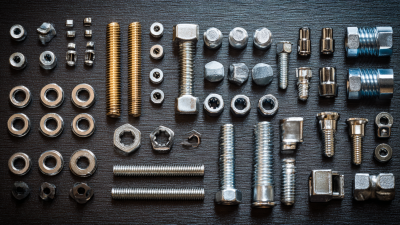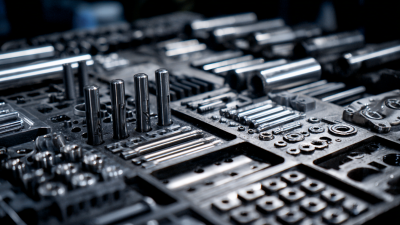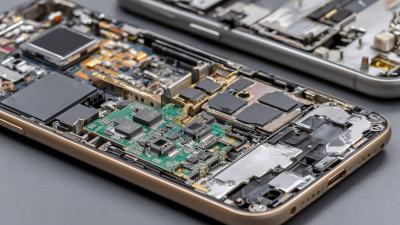 Selecting the right hardware parts is a critical step in ensuring the success of any project, whether it be in the realm of electronics, construction, or manufacturing. According to a recent report by Grand View Research, the global hardware market is projected to reach $1.8 trillion by 2025, showcasing the tremendous demand for quality components.
Selecting the right hardware parts is a critical step in ensuring the success of any project, whether it be in the realm of electronics, construction, or manufacturing. According to a recent report by Grand View Research, the global hardware market is projected to reach $1.8 trillion by 2025, showcasing the tremendous demand for quality components.
In this landscape, the importance of sourcing appropriate hardware parts cannot be understated, as they directly impact project reliability, performance, and cost-effectiveness. Furthermore, studies from the International Journal of Advanced Manufacturing Technology indicate that the optimal selection of hardware parts can enhance operational efficiency by up to 30%.
Therefore, understanding the criteria for hardware selection—such as compatibility, durability, and cost—becomes essential for anyone aiming to achieve their project goals effectively.
When embarking on a hardware selection process for your project, evaluating the project requirements is paramount. According to a report from the International Data Corporation (IDC), over 70% of IT projects face delays due to misaligned hardware choices. To avoid such pitfalls, start by clearly defining your project’s objectives. Understanding functional requirements, performance expectations, and budget constraints can streamline the selection of appropriate hardware components.

When selecting hardware components for your project, it's essential to understand the various types available and their specific uses. Different hardware parts serve unique functions, which can significantly impact the performance and efficiency of your project. For example, processors (CPUs) vary in speed and core count, and choosing the right one is crucial for tasks requiring heavy computations, such as gaming or data analysis. Similarly, graphics cards (GPUs) differ in rendering capabilities; high-end models can enhance visual performance in graphic-intensive applications, while lower-end options may suffice for everyday tasks.
Memory (RAM) is another critical component, as it affects how many tasks your system can handle simultaneously. Understanding RAM speed and capacity is vital when planning a system meant for multitasking or running memory-hungry applications. Storage options, such as SSDs or HDDs, also present variations in speed and durability, impacting data retrieval times and overall system responsiveness. By grasping these key variations and their appropriate applications, you can make informed decisions that align with your project needs and ensure optimal performance.
When embarking on a hardware project, assessing compatibility among components is crucial for ensuring seamless functionality. Each part—from the motherboard to the power supply—must work harmoniously to avoid issues like system failures and performance bottlenecks. Begin by researching the specifications of each component. Look for compatibility notes regarding socket types, bus speeds, and maximum capacities.

Tips: Always check the manufacturer’s website or technical sheets for updated compatibility lists. This can save you time and frustration down the road. Additionally, consider engaging in forums or online communities where fellow enthusiasts share their experiences with specific hardware combinations.
Another key aspect to consider is the form factor of your components, especially with cases and power supply units. A compact case may limit your options, while a standard ATX motherboard can give you plenty of room for upgrades. Moreover, ensure that the cooling solutions you choose are compatible with your CPU and that they fit within your case.
Tips: When in doubt, consult build guides or components compatibility checkers available online. They allow you to visualize how your chosen parts will fit together and perform, minimizing the risk of purchasing unsuitable components.
When selecting hardware parts for your project, budget considerations play a crucial role in ensuring that you strike the right balance between performance and cost. According to a recent industry report by Gartner, nearly 60% of businesses prioritize cost-effectiveness as a critical factor in hardware selection. This is especially true for startups and small enterprises, where every dollar counts and performance cannot be compromised for the sake of affordability.
To manage your budget effectively while achieving high performance, it's essential to conduct a thorough analysis of your project requirements. Consider components that offer scalability — investing in a slightly higher initial cost can lead to substantial savings in the long run, as reported by the International Data Corporation (IDC), which states that scalable solutions can reduce overall operational costs by up to 30%.
**Tip:** Evaluate open-source hardware options as they can often provide similar capabilities at a reduced cost, allowing for flexibility in your project budget.
Additionally, when assessing your component choices, look for warranties and after-sales support. Research shows that investing in quality hardware with comprehensive support can decrease downtime significantly, improving productivity and ultimately justifying the initial investment.
**Tip:** Always compare multiple suppliers to ensure you're securing the best price without sacrificing quality.
| Component Type | Performance Rating | Estimated Cost ($) | Recommended Use Cases |
|---|---|---|---|
| CPU | High | 300 | Gaming, Video Editing |
| GPU | Very High | 500 | Gaming, 3D Rendering |
| RAM | Medium | 100 | General Use, Gaming |
| SSD | High | 150 | Fast Boot, File Storage |
| Motherboard | Medium | 150 | Compatible with CPU, RAM |
| Power Supply | High | 80 | Stable Power Supply |
When selecting hardware components for a project, one of the most critical considerations is future-proofing. As technology evolves at an unprecedented pace, opting for scalable hardware ensures that your investment remains relevant over time. According to a report by Gartner, the global hardware market is projected to grow by 4.1% annually over the next five years. This growth underscores the importance of adaptability; choosing components that can be easily upgraded or expanded will save both time and resources down the line.
Taking into account the increasing demand for performance, scalability becomes imperative. For instance, research from IDC indicates that by 2025, 75% of data will be processed outside traditional data centers. Therefore, selecting hardware with robust connectivity options and modular architecture can effectively support your long-term operational goals. Look for components that offer compatibility with emerging technologies such as AI and IoT, which are expected to drive significant transformations across industries. Investing in scalable solutions not only prepares your project for current needs but also positions it strategically for future advancements.






